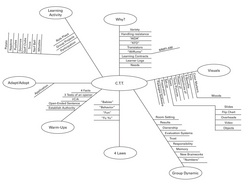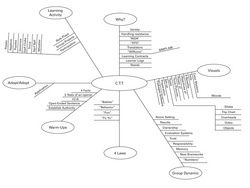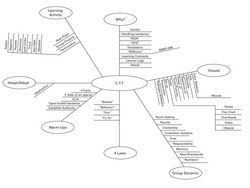


One of the greatest challenges when making presentations is preparing for them. Many people sit down, they pick up a sheet of paper, and their minds go blank. They don’t know where to start. Or they have so many ideas they don’t know how to organize them. Or they don’t have enough information to choose a format or decide on the points to be covered.
I have read a book called Use Both Sides of Your Brain by Tony Buzan that I feel is very helpful in putting presentations on the right track. A significant part of the book outlines a technique which Tony calls MindMapping. When I use MindMapping, it reduces the time it takes me to develop a presentation, a report, an article, or a letter by approximately 50 percent. Mind-Mapping allows me to use words to visually relate concepts and information in ways that are more enlightening than note taking or outlining. MindMapping a presentation helps me to take a look at how I may want to present the information. It enables me to focus not only on the content, but also on the sequence of the content. Following is a mind map I created in 10 minutes for this book. A mind map helps me to see not only what is there, but also what is missing.
Here are the fundamental aspects of MindMapping:
Start with your central thought.
Write this premise in the middle of a blank sheet of paper. Then, list the first support idea that comes into your mind in the 12:00 position. Next, note any related points. As you exhaust ideas on a topic, move to the 1:00 position and begin again. Continue around the clock.
Be free-flowing.
One of the models that I use for the mind looks like a pinball machine. It can bounce around very quickly to numerous ideas before it comes up with a logical conclusion.
We’ve all had this experience: Someone says something to you. You pause for a minute and then reply. Your listener asks where in the world your response came from. You reply, “You said this, which reminded me of that, and that made me think of that, which reminded me of that, and that’s why I said that to you.” For you, the thought progression was very logical, but anyone else looking at it can’t see how you got from the original statement to your reply. The MindMapping technique accommodates this type of bouncing around better than either note taking or outlining.
Use only key words.
Often when taking notes and creating an outline, we use too many words. Most people think faster than they write. (The human mind can think 1,200 to 1,600 words a minute. On average, most people only write freehand 25 to 35 words a minute, and the best of us can type little more than 100 words a minute.) So the key concept is to think in bullets and jot down one or two words that capture the concept. This way you won’t slow down your thinking.
Allow yourself to bounce around.
It may be that you get to the third or fourth key idea and suddenly you think of something that fits back with idea number one. That’s okay—stop, bounce back up, add the idea, and continue on.
Feel free to connect things that relate.
When two topics relate to one another, simply draw an arrow to connect them. The arrow may be drawn with the same color as the rest of the mind map or with another color to highlight clearly the intended connection.
Try short bursts.
Time yourself for five minutes. Then, take a break. Sit back. Look at your mindmap. Do something else. Then, spend another five minutes adding, modifying, and adjusting.
Use MindMapping alone or in groups.
A mindmap can be a tool you use with groups to have them summarize information you’ve just covered.
Remember, MindMapping is your tool. Let it work for you. Many people, when exposed to MindMapping, say, “I could never show this to my boss.” A mind map is not necessarily for others. Rather, it is primarily for yourself. Don’t use a mind map as a report. Instead, use the mind map to dictate or type the report. Use it to make sure that all the elements you want in the report are there before you start.
Take a Moment
On a separate piece of paper, construct a mind map, using the MindMapping process that has just been presented, for a presentation that you will most likely be giving in the next few months.
Adapted from High Impact Presentations by Bob Pike which is available at BobPikeGroup.com. A workshop version also is available.




3740 N Chestnut St #113 - Chaska, MN 55318-3053